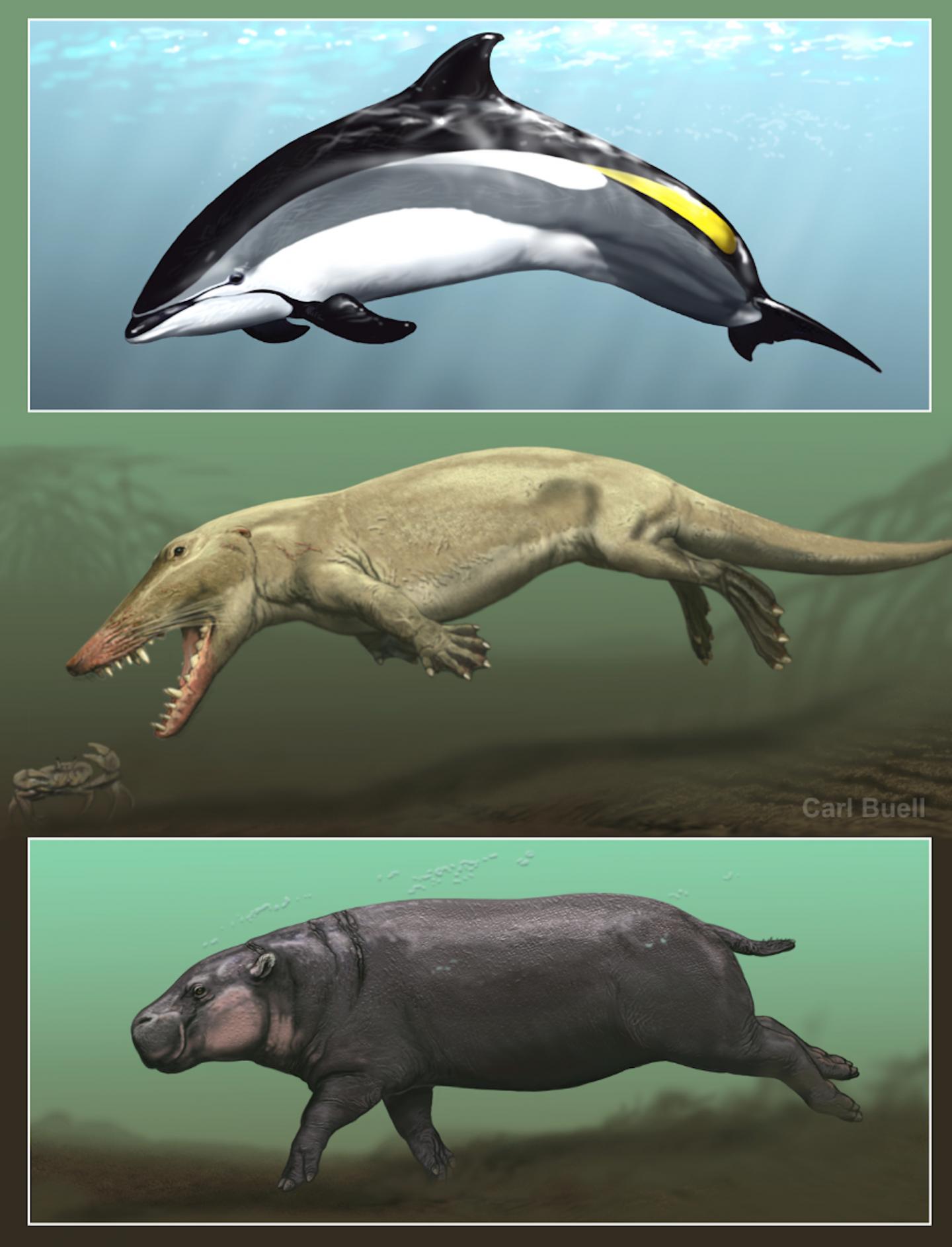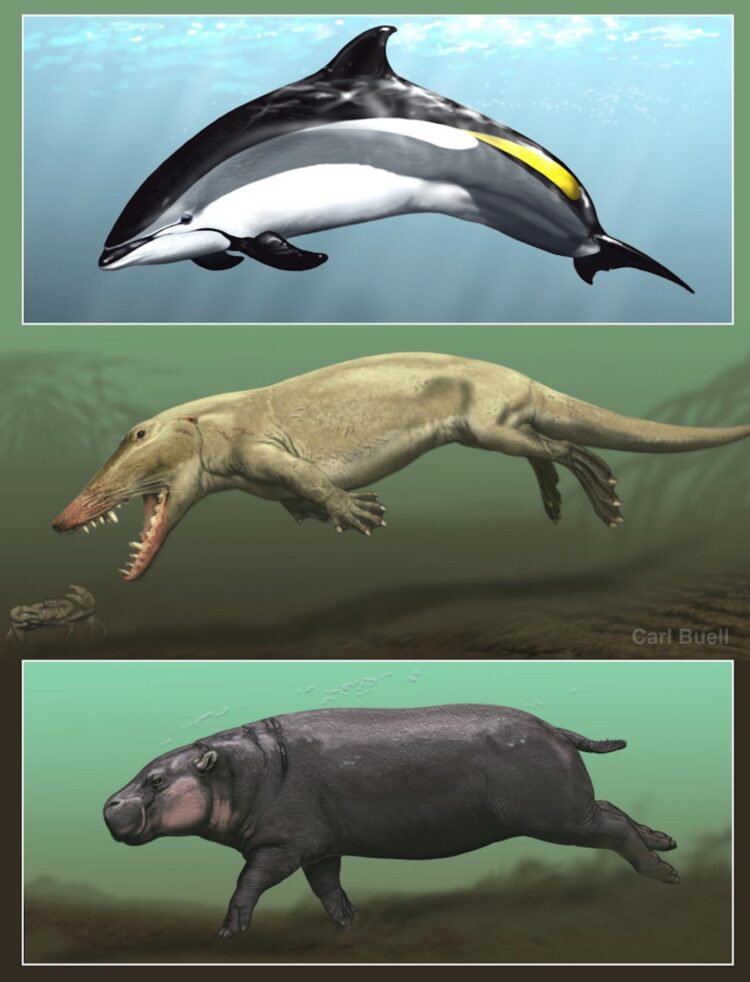Hippos and cetaceans are close relatives, but their shared “aquatic” skin traits did not come from a common ancestor

Credit: Carl Buell
A new study shows that the similarly smooth, nearly hairless skin of whales and hippopotamuses evolved independently. The work suggests that their last common ancestor was likely a land-dwelling mammal, uprooting current thinking that the skin came fine-tuned for life in the water from a shared amphibious ancestor. The study is published today in the journal Current Biology and was led by researchers at the American Museum of Natural History; University of California, Irvine; University of California, Riverside; Max Planck Institute of Molecular Cell Biology and Genetics; and the LOEWE-Centre for Translational Biodiversity Genomics (Germany).
“How mammals left terra firma and became fully aquatic is one of the most fascinating evolutionary stories, perhaps rivaled only by how animals traded water for land in the first place or by the evolution of flight,” said John Gatesy, a senior research scientist in the American Museum of Natural History’s Division of Vertebrate Zoology and a corresponding author on the study. “Our latest findings contradict the current dogma in the field–that relatives of the amphibious hippo might have been part of the transition as mammals re-entered life in the water.”
Despite their contrasting appearances, fully aquatic cetaceans–the group that includes whales, dolphins, and porpoises–and semi-aquatic hippopotamuses are each other’s closest living relatives and share a common ancestor that lived about 55 million years ago. They also share a number of characteristics that are odd for most mammals: they give birth and nurse underwater, and lack scrotal testes and sebaceous glands (that secrete oily sebum) as well as most of their hair. Since these traits are rarely found in other mammals, one would assume that they were already present in the common ancestor of hippos and cetaceans. But how and when cetacean ancestors became fully aquatic remains a subject of intense debate.
Paleontological studies on transitional extinct cetaceans suggest that entry into water was a gradual process that included amphibious phases. So did hippos and cetaceans develop adaptations for an aquatic lifestyle independently? Or was their common ancestor already amphibious, and from there, cetaceans diverged to become fully aquatic?
“The simplest hypothesis is that the ancestor of whales and hippos was already amphibious, but evolution isn’t always the shortest distance between two points,” said the study’s lead author Mark Springer, a biology professor at the University of California, Riverside.
To help resolve this question, the researchers looked to the animals’ skin, which shows profound evolutionary changes in response to aquatic life.
“When a group of animals becomes aquatic, skin becomes much more streamlined and uniform throughout,” said Maksim Plikus, a co-corresponding author and a skin biologist from the University of California, Irvine. “Complex derivatives like hairs, nails, or sweat glands are no longer needed, and in fact, can become a hinderance to life under water, so those go away. And it loses the barrier function performed by the outer layer of skin, which in terrestrial mammals, is vital to keeping water from evaporating out of the body and preventing pathogens from getting in.”
The researchers compared the anatomy of hippo and cetacean skin based on histology and used genomic screens to compile a comprehensive list of “skin genes” that have been inactivated in both hippos and cetaceans. This was aided by examining–for the first time–the genome of the pygmy hippo, Choeropsis liberiensis, one of only two living hippo species.
“When you look at the molecular signatures, there is a striking and clear answer,” said study co-corresponding author and evolutionary genomicist Michael Hiller, from the Max Planck Institute of Molecular Cell Biology and Genetics and the LOEWE-Centre for Translational Biodiversity Genomics in Germany. “Our results strongly support the idea that ‘aquatic’ skin traits found in both hippos and cetaceans evolved independently. And not only that, we can see that the gene losses in the hippo lineage happened much later than in the cetacean lineage.”
These gene results are in line with examinations of the skin itself: Unlike whales, hippos actually do have a very specialized kind of sweat gland that produces “blood sweat,” an orange-colored substance that is speculated to have natural anti-microbial and sunscreen properties. And while cetaceans only have a few whiskers, hippos are fully whiskered but also have sparse body hairs, most prominent on their ears and the tip of their tail. The latter are used when hippos defecate, during which they quickly spin their tail and the brush-like hairs help to pulverize the feces all around as a way to mark territory. In addition, cetacean skin is much thicker than hippo skin, and hippos are alone in having hooves.
“These differences are fully consistent with the record of evolutionary history that is written in their genomes, which shows the independent knockout of skin genes on the cetacean lineage and on the hippo evolutionary line,” Springer said. “None of the inactivating mutations that would have suggested a common aquatic ancestry are shared between these two lineages.”
###
Other authors on the study include Christian Guerrero-Juarez and Raul Ramos from the University of California, Irvine; Matthias Huelsmann from the Max Planck Institute of Molecular Cell Biology and Genetics; Matthew Collin from the University of California, Riverside; Kerri Danil from the National Oceanic and Atmospheric Administration; Michael McGowen from the Smithsonian Museum of Natural History; and Ji Won Oh from Kyungpook National University.
This work was supported by the U.S. National Science Foundation grant no.s DEB-1457735, DMS-1951144, DMS-1763272, and an NSF-Simons Postdoctoral Fellowship; the National Institutes of Health grant no.s U01-AR073159 468 and P30-AR075047; Pew Charitable Trust; LEO Foundation; UC Irvine Chancellor’s ADVANCE Postdoctoral Fellowship Program; Simons Foundation Grant no. 594598; Howard Hughes Medical Institute Hanna H. Gray Postdoctoral Fellowship Program; the Max Planck Society; LOEWE-Centre for Translational Biodiversity Genomics, and the Hessen State Ministry of Higher Education, Research and the Arts.
Study DOI: 10.1016/j.cub.2021.02.057
ABOUT THE AMERICAN MUSEUM OF NATURAL HISTORY (AMNH)
The American Museum of Natural History, founded in 1869 and currently celebrating its 150th anniversary, is one of the world’s preeminent scientific, educational, and cultural institutions. The Museum encompasses more than 40 permanent exhibition halls, including those in the Rose Center for Earth and Space, as well as galleries for temporary exhibitions. The Museum’s approximately 200 scientists draw on a world-class research collection of more than 34 million artifacts and specimens, some of which are billions of years old, and on one of the largest natural history libraries in the world. Through its Richard Gilder Graduate School, the Museum grants the Ph.D. degree in Comparative Biology and the Master of Arts in Teaching (MAT) degree, the only such free-standing, degree-granting programs at any museum in the United States. The Museum’s website, digital videos, and apps for mobile devices bring its collections, exhibitions, and educational programs to millions around the world. Visit amnh.org for more information.
Media Contact
Kendra Snyder
[email protected]
Related Journal Article
http://dx.





